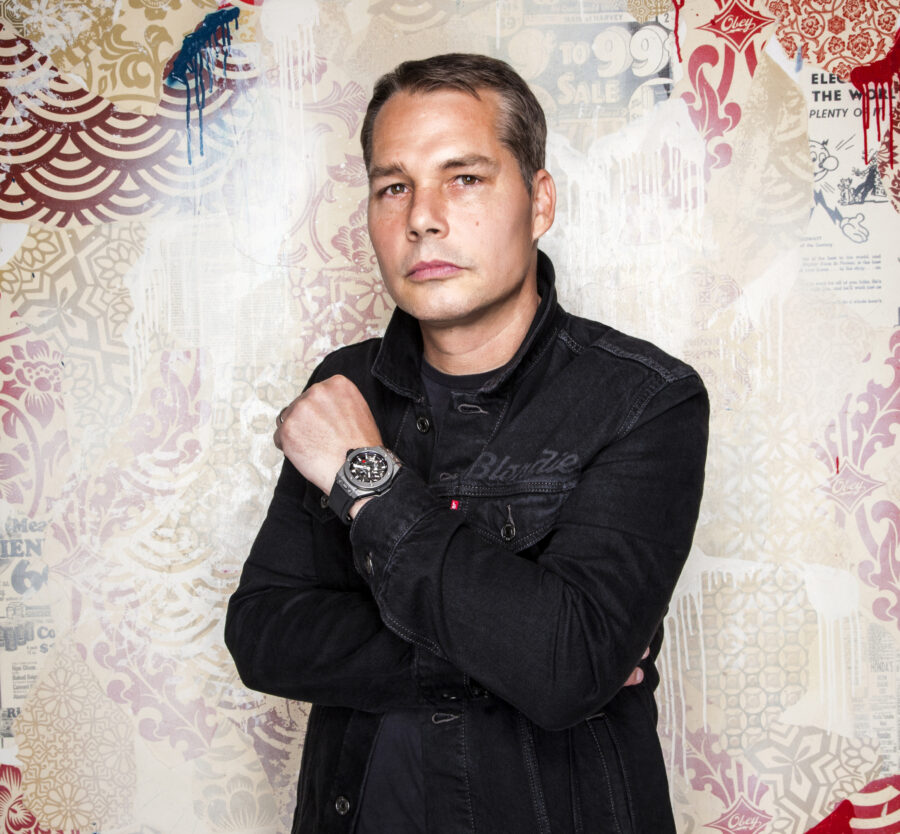Frank Shepard Fairey, one of the most formative and, at the same time, most controversial figures in contemporary street art and graphic design, has spent over three decades exploring the boundaries between high culture and subculture, art and commerce, activism and aesthetics. His work, ranging from ephemeral stickers to monumental murals and globally marketed clothing, demands a nuanced examination that considers his complex strategies of image appropriation, his propaganda-like visual language, and his tireless socio-political engagement. This article examines Fairey’s career, the development of his iconic “OBEY Giant” campaign, his artistic methods and influences, as well as the critical reception and controversies that continue to accompany his work to this day.
The Genesis of a Street Art Provocateur
The origins of Shepard Fairey’s artistic career are deeply rooted in the subcultures of the late 1980s, yet his development is equally shaped by formal art education. This duality forms the foundation of his unique approach.
From Charleston to RISD: Early Influences and Artistic Awakening
Born on February 15, 1970, in Charleston, South Carolina, Frank Shepard Fairey showed an early interest in art by transferring his drawings onto T-shirts and skateboards. This direct application of art to everyday objects, especially within youth subcultures, anticipated his later direct, public-facing methods. Raised in a middle-class environment – his father was a doctor, his mother a real estate agent – he developed an attitude of rebellion that seems more a conscious choice than a product of inherent marginalization. His education first took him to the Idyllwild Arts Academy in California, from which he graduated in 1988, and then to the renowned Rhode Island School of Design (RISD), where he earned his Bachelor of Fine Arts in Illustration in 1992. Parallel to his formal education, Fairey worked part-time in a skateboard shop. This activity, combined with his interest in punk music, solidified his connection to street culture and graffiti. This symbiosis of formal training and subcultural immersion is crucial to his later work. While his technical skills were honed in an institutional setting, his ethos and distribution strategies were shaped in countercultural spaces.
The “Andre the Giant Has a Posse” Campaign: An Experiment in Phenomenology and Viral Art
The legendary “Andre the Giant Has a Posse” campaign began in 1989 while Fairey was still studying at RISD. Its origin was rather coincidental: while demonstrating stencil-making to a friend, he used an image of the wrestler Andre the Giant from a newspaper advertisement. He borrowed the term “Posse” from the hip-hop jargon of the time. Fairey himself described the campaign as “an experiment in phenomenology.” His intention was to arouse curiosity and encourage people to question their relationship with their surroundings. The sticker’s meaning was deliberately kept ambiguous: “The sticker has no meaning but exists only to cause people to react, to contemplate and search for meaning in the sticker.” The distribution of the stickers by the skater community and graffiti artists demonstrated an early understanding of viral, decentralized distribution. Tens of thousands of stickers were spread worldwide. This early success became the blueprint for his later, more overtly political works.
This campaign later evolved into “Obey Giant,” partly due to the threat of a lawsuit from Titan Sports, Inc. in 1994. This prompted Fairey to create a more iconic image of the wrestler and adapt the slogan “OBEY,” a direct homage to John Carpenter’s film They Live (1988). This transition signaled the beginning of a brand identity development. Helen Stickler’s 1995 documentary “Andre the Giant Has a Posse,” which chronicled the early campaign and was screened at the 1997 Sundance Film Festival, marked an early point of critical recognition.

The OBEY Ethos, Aesthetics, Propaganda, and Participation
The OBEY ethos is characterized by a specific visual language, an engagement with propaganda aesthetics, and the aim of encouraging viewer participation and reflection.
Decoding Fairey’s Visual Language: Stencils, Screen Printing, Collage, and Graphic Impact
Fairey’s style is unmistakable, characterized by bold lines, a limited color palette – often red, black, and white/cream – and graphic designs. His primary techniques include stencil art, wheatpasting (attaching paper works with paste), and screen printing, which allows for mass production.
Collage is another essential technique. By assembling various materials such as newspaper clippings and photographs, he creates textured compositions. He often creates a collaged surface before printing on it. His works frequently feature stylized portraits, abstract patterns, and bold, sans-serif typography.
Artistic Genealogy: Echoes of Pop Art, Constructivism, and Propaganda
In his work, Fairey combines appropriated commercial images in the style of Pop Art with strong geometric lines and shapes reminiscent of Russian Constructivism. This connection draws parallels between advertising and propaganda. The influence of Soviet propaganda posters and artists like Alexander Rodchenko is particularly discernible.
His work often blends elements of propaganda and commercial design, prompting viewers to think critically about media consumption. Fairey borrows the aesthetics of propaganda to critique contemporary power structures and strategically reverses its purpose. The “OBEY” slogan itself is a prime example of this ironic appropriation. Other influences include punk music, skateboard culture, and street artists like Keith Haring and Jean-Michel Basquiat. He also quotes Marshall McLuhan (“The Medium is the Message”).
The Medium as Message: Democratization of Art and Questioning Public Space
Fairey’s work blurs the distinction between fine and commercial art. His stated goal is to “democratize art” and reach people through as many platforms as possible. Street art is intended to encourage people to give the work their own interpretation, aligning with his early phenomenological aims. He questions traditional art venues: “Galleries and museums have their place, but they shouldn’t be the only places where people can experience art.” The street thus becomes an accessible gallery.
The OBEY campaign has changed the language between art and urban space. His “guerrilla tactics” inspired a new generation of street artists. Fairey’s consistent use of public space is a direct implementation of his philosophical goals. By placing art directly into the urban environment, he forces an encounter outside the curated context of galleries.
Pioneering Works and Cultural Interventions
Shepard Fairey’s influence is manifested in several key works and strategic interventions.
The “Hope” Poster: An Icon of Political Imagery and its Complex Legacy
The “Hope” poster, created for Barack Obama’s 2008 presidential campaign, became a globally recognized symbol. The image, in its stylized red, white, and blue color scheme, captured a sense of optimism and mobilized support. It catapulted Fairey to global fame and brought institutional recognition, as evidenced by the poster’s inclusion in the National Portrait Gallery in Washington D.C. At the same time, this visibility subjected the work to intense criticism. The fact that the poster was based on an Associated Press photograph by Mannie Garcia led to a major copyright dispute.
From the Street to the Gallery and Beyond: Large Murals, Exhibitions, and Institutional Recognition
Fairey’s works have been exhibited in numerous renowned institutions, including the Smithsonian, MoMA in New York, LACMA, the Victoria and Albert Museum in London, and the Institute of Contemporary Art in Boston. He has had numerous solo and group exhibitions internationally. Over 110 large-scale murals on six continents testify to his global presence in public space. Fairey’s career demonstrates a masterful navigation of the art world. He maintains his credibility in the “street art” scene through continuous public works while simultaneously achieving significant success in established institutions.
OBEY Clothing: Branding Dissent and Commercializing Counterculture
In 2001, Fairey founded OBEY Clothing. The brand combines fashion and activism, using clothing as a canvas for his visual messages rooted in an anti-authoritarian, anti-capitalist stance. However, this commercial enterprise is controversial. Some critics see it as a cynical commodification.
The existence of OBEY Clothing presents a central paradox in Fairey’s practice: a brand built on an “anti-capitalist orientation” itself participates in the system it criticizes. This can be interpreted as a pragmatic way to fund activism or as an inherent contradiction.

Navigating the Critical Labyrinth, Controversy and Dialogue
Fairey’s career is marked by controversies that have sparked important debates.
The Shadow of Appropriation: Debates on Originality, Fair Use, and Artistic Sourcing
Fairey has repeatedly faced accusations of using other artists’ work without permission or proper attribution. Critics like Mark Vallen have documented cases where Fairey appropriated imagery from various sources. Fairey’s defense often relies on the idea of recontextualization and transformation. He argues that his work critiques image ownership.
This practice sparks a debate about the line between influence and theft. Fairey’s use of appropriation is a conscious artistic strategy that comments on the nature of images in a media-saturated world. By “sampling” and recontextualizing existing imagery, he aims to deconstruct its original intent.
Legal Disputes and Public Scrutiny: The AP Lawsuit and Other Challenges
The most prominent legal dispute was the lawsuit by the Associated Press (AP) over the “Hope” poster. Fairey initially sued AP seeking a declaration of fair use. AP countersued for copyright infringement. The case was settled in 2011, with Fairey agreeing not to use other AP photos without a license and to share profits. Later, Fairey was convicted of submitting false evidence during the proceedings, resulting in probation and a fine.
Fairey has been arrested multiple times for graffiti and vandalism, often close to moments of mainstream success. The AP lawsuit became a public focal point for discussions on intellectual property and artistic freedom.
Critical Reception: Between Subversive Agitator and Commercial Giant
Critical reaction to Fairey is divided. Some see his work as potent political art. Others accuse him of cynically turning graffiti culture into an advertising campaign or describe his art as “generic.” His defenders argue that criticism often misunderstands his use of appropriated imagery. Steven Heller places his work in line with Andy Warhol’s transformations. There is a certain irony in Fairey himself using legal means to prevent others from appropriating his “Obey” works.
Critical reception revolves around the tension between his subversive intentions and his commercial success. Critics question whether genuine dissent can be sold as a brand.

Shepard Fairey Today, Ongoing Activism, Evolving Practice, and Legacy
Even after more than three decades, Shepard Fairey remains an active voice.
Contemporary Engagements: Addressing Social Justice, Environmental Protection, and Political Discourse
Fairey continues to create art that raises awareness of social issues. He frequently donates artworks or creates pieces to support grassroots initiatives, including the Obey Giant Art Foundation and projects supporting Darfur or the Zapatista Army. His more recent works include tributes to figures like Frida Kahlo and Ruth Bader Ginsburg, as well as posters for the “Vote” campaign and the “We The People” series.
Recent Ventures: Exhibitions, Murals, and Market Presence
Ongoing exhibitions like “Facing the Giant: Three Decades of Dissent” and “Golden Compass” in Bangkok testify to his continued activity. He continues to create large-scale public murals, such as “Interdependent Nature” in Mesa, Arizona, often with themes of peace and justice. Fairey’s recent projects show consistency in core themes and development in approach.
His works maintain a strong presence in the art market. He is represented by galleries such as Taglialatella Galleries and GGA Gallery.
Assessing Influence: Shepard Fairey’s Lasting Impact on Street Art and Contemporary Visual Culture
Shepard Fairey is considered one of the best-known and most influential street artists. His work has changed the way people see art and urban space. He played a crucial role in shaping street art culture. His fusion of art, activism, and branding has created a unique model.
The debates surrounding his work continue to fuel important conversations. Fairey’s legacy may lie as much in the questions he raises as in the art he creates. His career has consistently pushed boundaries: between street and gallery, activism and commerce, appropriation and originality. His lasting influence is therefore attributable not only to his visual style but also to his role as a catalyst for critical discourse.
Shepard Fairey’s career is a complex tapestry of artistic innovation, subversive strategy, political engagement, and commercial success. From the beginnings of the “Andre the Giant Has a Posse” stickers to icons like the “Hope” poster and the OBEY brand, Fairey has masterfully used and questioned the mechanisms of visual communication. His appropriation of propaganda language, his use of the street as a democratic exhibition space, and his addressing of controversial topics have made him a key figure.
The controversies surrounding appropriation and commercialization are integral parts of his work. They reflect the tensions faced by artists operating between a critical stance and market mechanisms. Fairey’s ability to be present in both established institutions and on the street testifies to his adaptability and understanding of the cultural landscape.
Ultimately, Shepard Fairey’s lasting significance may lie less in definitive answers than in the persistent questions his work raises: about the power of images, the responsibility of the artist, the limits of originality, and the possibility of using art as an instrument of social change. His call to critically examine one’s surroundings and question authority remains as relevant as ever.









